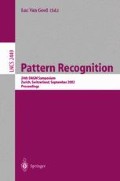Abstract
In this paper, we examine the applicability and repeatability of a genetic algorithm to automatically correlate horizons across faults in seismic data images. This problem arises from geological sciences where it is a subtask of structural interpretation of those images which has not been automated before. Because of the small amount of local information contained in seismic images, we developed a geological model in order to reduce interpretation uncertainties. The key problem is an optimisation task which cannot be solved exhaustively since it would cause exponential computational cost. Among stochastic methods, a genetic algorithm has been chosen to solve the application problem. Repeated application of the algorithm to four different faults delivered an acceptable solution in 94–100% of the experiments. The global optimum was equal to the geologically most plausible solution in three of the four cases.
Access this chapter
Tax calculation will be finalised at checkout
Purchases are for personal use only
Preview
Unable to display preview. Download preview PDF.
References
L. C. Lawyer, From the Other Side, The Leading Edge, Vol. 17, No. 9, 1998, pp. 1190–1191.
G. A. Dorn, Modern 3-D Seismic Interpretation, The Leading Edge, Vol. 17, No. 9, 1998.
M. S. Bahorich, and S. L. Farmer, 3-D Seismic Discontinuity for Faults and Stratigraphic Features, The Leading Edge, Vol 14, No. 10, 1995, pp. 1053–1058.
K. J. Marfurt, R. L. Kirlin, S. L. Farmer, and M. S. Bahorich, 3-D Seismic Attributes Using a Semblance-Based Coherency Algorithm, Geophysics, Vol. 63, No. 4, 1998, pp. 1150–1165.
G. Fehmers, Shell Research, Netherlands, personal communications.
P. Alberts, M. Warner, and D. Lister, Artificial Neural Networks for simultaneous multi Horizon tracking across Discontinuities, 70th Annual International Meeting, SEG, Calgary, Canada, 2000.
L. F. Kemp, J. R. Threet, and J. Veezhinathan, A neural net branch and bound seismic horizon tracker, Expanded Abstracts, 62nd Annual International Meeting, SEG, Houston, USA, 1992.
M. Aurnhammer and K. Tönnies, Horizon Correlation across Faults Guided by Geological Constraints, Proceedings of SPIE, Vol. #4667, Electronic Imaging 2002, 21–23 January, San Jose, California USA. In press.
J. H. Holland, Adaption in Natural and Artificial Systems (MIT Press, 1975).
D. E. Goldberg, Genetic Algorithms in Search, Optimization and Machine Learning (Addison-Wesley, 1989).
Author information
Authors and Affiliations
Editor information
Editors and Affiliations
Rights and permissions
Copyright information
© 2002 Springer-Verlag Berlin Heidelberg
About this paper
Cite this paper
Aurnhammer, M., Tönnies, K. (2002). The Application of Genetic Algorithms in Structural Seismic Image Interpretation. In: Van Gool, L. (eds) Pattern Recognition. DAGM 2002. Lecture Notes in Computer Science, vol 2449. Springer, Berlin, Heidelberg. https://doi.org/10.1007/3-540-45783-6_19
Download citation
DOI: https://doi.org/10.1007/3-540-45783-6_19
Published:
Publisher Name: Springer, Berlin, Heidelberg
Print ISBN: 978-3-540-44209-7
Online ISBN: 978-3-540-45783-1
eBook Packages: Springer Book Archive

